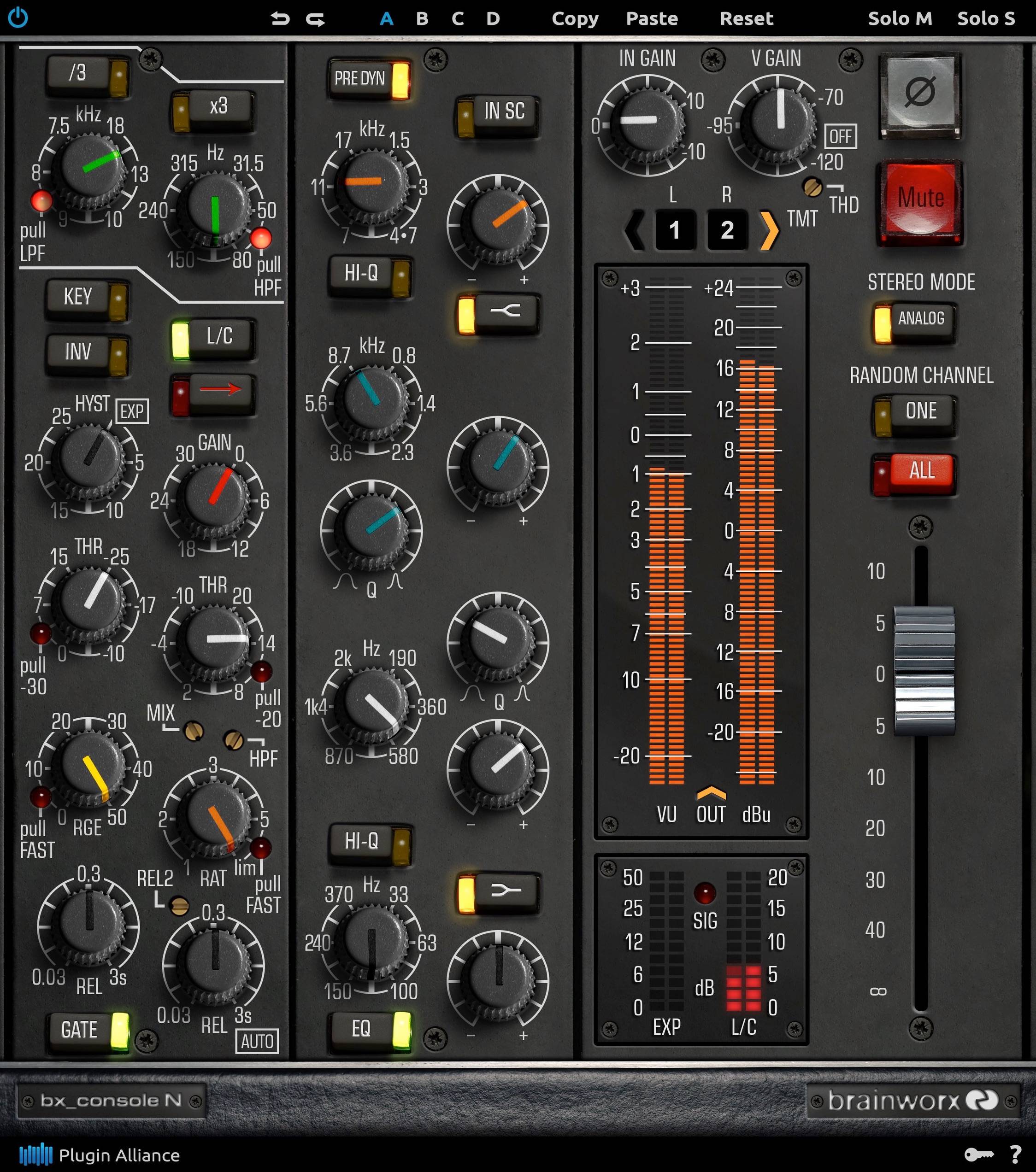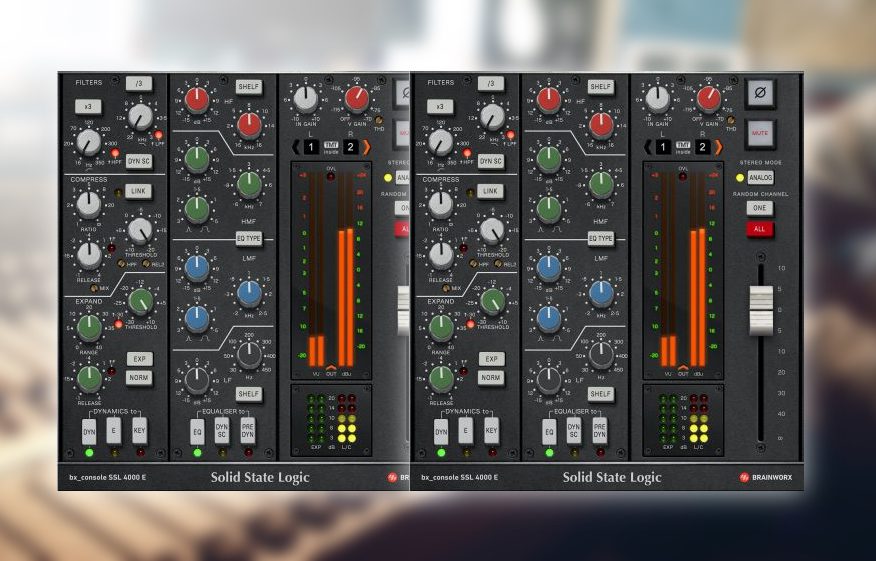Brainworx, being the sticklers for authenticity that they are, picked the road less traveled and not only modeled multiple channel strips of a well-maintained SSL 4000 E (which has been done once before).
Channel strip plug-in emulates E Series SSL with G Series features- Bxconsole SSL 9000 J The big, deep and clear sound of the Solid State Logic 9000 series consoles is now available through the Plugin Alliance, brought to you by Brainworx. With the power of TMT, this officially-authorized bxconsole SSL 9000 J plugin allows you to build a 72-channel analog SSL console inside your DAW.
- Brainworx is arguably the most versatile plugin developer out there. They have developed the biggest part of our PA catalogue, including most of our analog modeled plugins! And BX is the biggest 3rd party vendor for the prestigious UAD-2 platform, and the #1 AAX DSP developer for AVID's ProTools HDX system as well.
Plug-in developers Brainworx have released bx_console E — a new 72-channel emulation of the SSL E Series console, complete with compressor/limiter, expander/gate, four-band parametric EQ, and wide-ranging high- and low-pass filters. The new plug-in pairs these features with the same flexible signal routing found on the original console.

The plug-in applies the same Tolerance Modelling Technology (TMT) used in their previous bx_console channel strip plug-in to simulate the channel-to-channel variances of the E Series’ electronic components on each and every instance of the plugin. And, Brainworx claim that the plug-in has an extremely low CPU load.
Brainworx’s bx_console has the added advantage of letting you choose — on a per-channel basis — between the original console’s EQ revisions ('black' or 'brown') or to substitute the compressor’s VCA (Voltage Controlled Amplifier) with that from the later-released British G Series console.
Brainworx have added a wealth of modern functions to the E Series’ vintage circuitry such as: a dry/wet control; an optional secondary release time (REL2) control that prevents the compressor from pumping on delicate acoustic tracks, and an adjustable HPF (High Pass Filter) for the compressor’s sidechain.
There’s also a continuously-variable THD (Total Harmonic Distortion) control that adds saturation; two alternative threshold ranges for the expander and gate; the gate’s HYST (Hysteresis) control which sets a dedicated closed threshold up to 25 dB lower than the open threshold, preventing sustained guitar notes and ringing cymbals from making the gate stutter. A continuously-variable Virtual Gain knob adds simulated analogue noise to any of the channels and EUCON parameter mapping is provided for Avid controllers.
Bx Console E
The bx_console E plug-in is available in AAX Native & DSP, AU, VST2, and VST3 formats exclusively from Plugin Alliance. It has an introductory promo price of $179 until August 31, 2017, rising to $299 thereafter. A fully-functional, 14-day trial is available to anyone registering for a free Plugin Alliance account here: http://www.plugin-alliance.com/en/registration.html.
https://www.plugin-alliance.com/en/products/bx_console_e.html- Sound
- Features
- Ease Of Use
Brainworx BX consoles E and G Review
These are channel strips plain and powerful. They sound great, are very flexible, and very similar!
Pros
– True to the ‘SSL tone’
– Light on the CPU
– Great control over the analog noise and distortion
Cons
– Not cheap, especially if you can’t decide between the two!
Plugin Alliance has, over the last few months, released several different console emulations to fit across your mix in a DAW, creating the analog inconsistencies and quirks that please the ear when it comes to making music out of the box.
Brainworx Ssl Vs Waves
In this review, I’ll walk through the structure for two of the emulations, as they’re identical with a couple exceptions, and then I’ll do my best to compare and contrast the ‘tone’ created by the emulations of the different desks, and what you can expect them to do when put on your mix.
These console emulations are of two SSL desks, one from the 70’s, and one from the 80’s, complete with the different characteristics that each console had.
The emulations each contain 72 channels, with extremely subtle tonal differences within the filter, compression, expander, gate, and EQ modeled on the original strips on the desks. More on this in a bit.
These plugins contain all the elements that were present on each channel, with the addition of some new hybrid elements that weren’t on the original, to bring the plugins into contemporary digital mix world.
Each plugin has 3 main sections; dynamics, EQ and the metering/Channel selection. Dynamics and EQ can be turned on and off at the bottom of each section.
Dynamics contains:
2 filters, Hi-pass and Lo-pass. You can triple the frequency range of each filter, as well as place it on the inputs of the Compressor if you wish.
The classic SSL compression is here, in its simple form. No menu diving on this one, there’s 3 basic knobs; ratio, threshold and release. The attack is automatic, unless you press a button to override to a fast attack.
One thing I absolutely loved about the compressor was the Mix control – adding dry signal back into the compressed sound, so if you’re too lazy to buss to parallel comp, you can do it all there in the plugin. Brilliant.
You can also stereo link if it’s a stereo signal, giving smoother stereo compression, instead of dual mono.
Expansion/gate. You can switch between the two here. Again it’s a simple powerful affair, with range, release, threshold and hysteresis knobs. The range affects the gain reduction, and the threshold dictates at what level the gate/exp kicks in. You can also switch to the inverse signal (you only hear the ducked signal).
The dynamics section can be swapped between the two series, so you can have the E or G dynamics on either plugin. This is fantastic, almost giving you 2 plugins for the price of one.
You can switch out depending on whether you want the more colourful E comp or the tighter more precise G comp, along with the exp/gate and filters that come with it.
The side chain is available on all the dynamics processing on both plugins. I absolutely love sidechaining, as I find it tightens up my mixes immensely. I’ve never done much sidechaining other than with compression, but using it with a gate was a great learning experience. Being able to open the gate on any track when the Kick hits can really tighten up a mix rhythmically.
EQ section
The EQ is 4 band – 2 shelves and 2 parametric bands. Each of the plugins has a switchable EQ type – in the E console it’s black and brown knob, and with the G it’s orange and pink knob.
On the G series, with the pink knob, there’s a x and / by three for the High mid and low mid freqs for a slightly wider frequency range than the E series.
I found the G series EQ slightly more aggressive in its sculpting than the E series, especially the pink knob version. It gave some serious punch to drums, compared to the other EQ’s. Both EQ’s are very flexible, with distinct tonal characteristics.
I also found the G to sound warmer to my ears. Less cutting than the E. But I definitely found that material responded completely differently to the two EQ’s, and your ears will pick up and appreciate different EQs for different source material.
Having the different colour knob flavours just gives you more choice to pick from! You can place the EQ before, in the middle of (side chain), and after the dynamics section.
Metering
This is not just the basic utilitarian section. Yes, it has metering of the main signal, expansion and compression, in and out gain, phase and mute; all the standard bits on a metering section. But the additions to my mind are where the BX console plugins start to stand apart from their competition.
TMT – this element is what sets the BX consoles emulations apart, to my mind. Not only does the plugin emulate the hardware, it goes channel to channel, and emulates the tiny tonal differences between each channel, from each section.
Once you’ve instantiated the plugin on several (or all) your tracks, you can control which ‘channel’ of the mixer each track runs through. You can go through and select a channel on each track, you can randomise one track, or you can randomize all your tracks at once. Heard one channel at a time, I could sometimes hear distinct differences in the way the plugin responded to the source material.
Sometimes I couldn’t hear any difference at all. All your settings are kept the same, so you’re simply clicking through the different channels, until something pops out, or you give up. But where this truly shines, to my ears, was on full mixes.
As our favourite philosopher, Marilyn Monroe, once said, “Imperfection is beauty”. Where this plugin really sings is where the ear picks up on slight imperfections in the sound, making the overall picture richer, fuller and wider.
Flicking through the ‘random all’ button I found caused really interesting changes in the mix – stuff would get darker, or closer, or stick out a bit. You can turn the TMT off, and have every channel identical, which is a good way to check you’re not going mad, or convincing yourself of something that’s not there!
The V-gain knob adds analog noise to the signal. It’s slightly fluctuating, and changes depending on the channel, so it’s not just straight noise. There’s thought gone into the noise! I really like the fact that you can choose whether to have the analog noise in or not, and you can adjust the amount. Per channel.
THD – this is possibly my favourite little knob in these plugin series. It adds harmonic distortion to each channel separately.
The combination of this and the modeling of slight differences in each channel just give the analog flavor, that warmth, color, grit that you might be looking for.
I love that you can dial it in per channel, so if you want some guitars dirtied up, but you want to keep the percussion and piano cleaner, then it’s as simple as turning some knobs, to get more of that analog distortion, and still keep the clean digital signal running through other channels. Here’s a (low quality) video showing Dirk explaining how the console itself had varying tolerances between each channel on his (and other) consoles.
I also like the surprisingly low CPU putting these plugins across the whole mix. It gives you all the basic sound shaping requirements you need on every channel. If only there was something like the Console 1 to enable you to use hardware mapped automatically to the plugins across the mix. That would be extremely useful!
Conclusion
These are channel strips plain and powerful. They’re designed to lay across all the channels of your final mix, so they’re coded light on CPU. They sound great, are very flexible, and very similar.
The differences tonally are there, but the best way to decide which you prefer is to demo them yourselves. I personally preferred the G console. I felt it was easier for me to give mixes more punch, and weight. But I did love the fact that you could swap out EQ’s and Comps on both plugins, giving you a lot of variety within the plugin. I absolutely loved the control over the analog noise and distortion, and the extra flavor the TMT brought.
Highly recommend both – but definitely check the demo versions to see which your ears prefer!
They’re $299 apiece, but who knows what the Christmas sale will bring!! More info on the Plugin Alliance website.
DISCLOSURE: Our posts may contain affiliate links, meaning when you click the links and make a purchase, we receive a commission.
